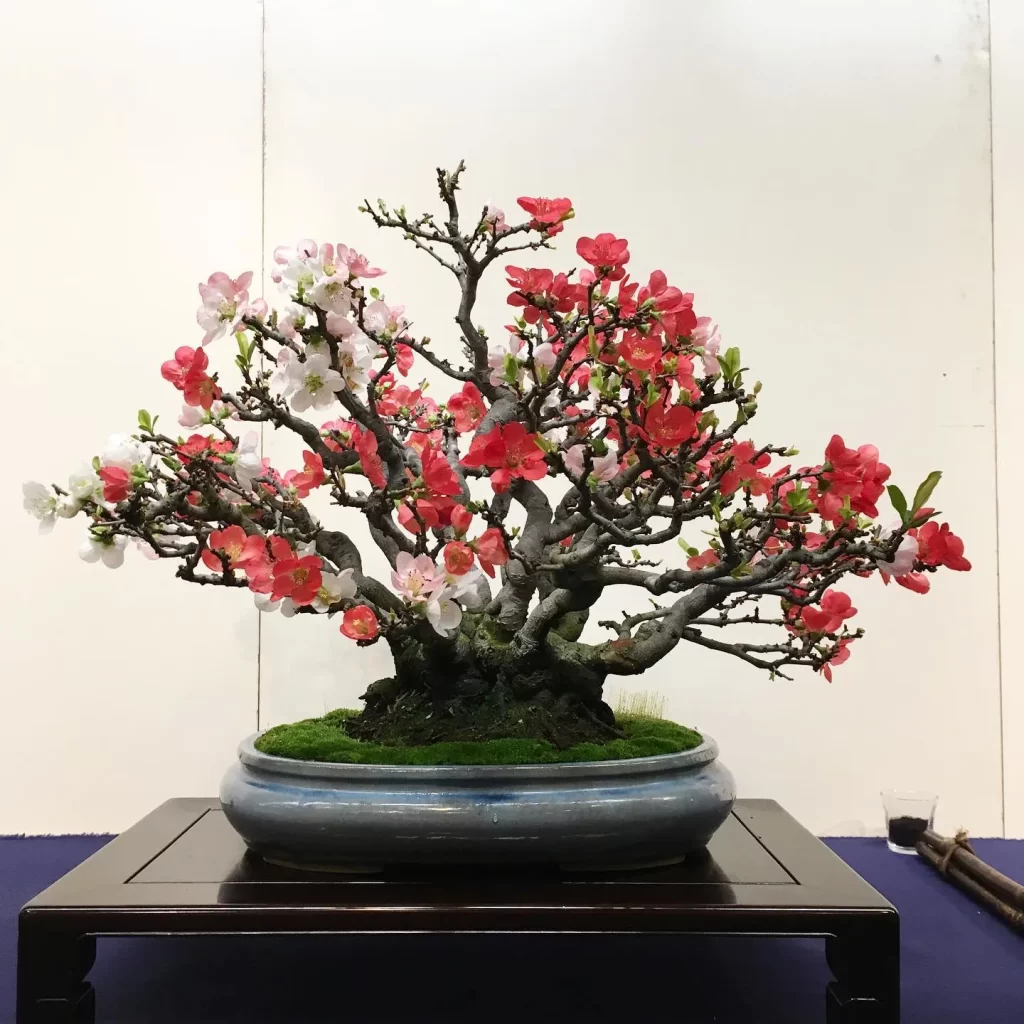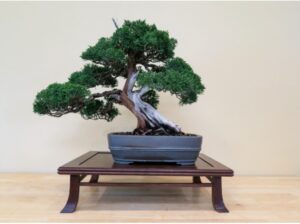Japanese Quince — (Choujubai) 長寿梅 / (Kusaboke) 草木瓜
Chouju 長寿 translating as longevity/long living and bai 梅 meaning Japanese plum (quince produce large seed pods similar to ume).
The Chaenomeles, commonly known as Flowering Quince or Japanese Quince, is a cherished species in bonsai cultivation known for its beautiful blossoms. Originating from East Asia, this species captivates bonsai enthusiasts with its exquisite flowers, ornamental fruits, and graceful form.
The name of the plant genus has an interesting etymology. It is a reference to the shape of the fruit. Namely, the word Chaenomeles comes from the Greek composite term ‘chainein’. ‘Chaeno’ means ‘to split’, and ‘meles’ means ‘apple or fruit’. On the other hand, the common name Flowering Quince is of Middle English origin, with root in the Old French ‘cooin’ and the Late Latin ‘cotoneum’, both meaning ‘apple’.
With varieties ranging from the traditional Flowering Quince to the diminutive ‘Chojubai’ the Chaenomeles bonsai offers a diverse range of options.
The Dwarf Flowering Quince, known as ‘Chojubai’ in Japanese, is a prized cultivar valued for its miniature size, prolific flowering, and intricate branching structure. The Chojubai is a favorite among bonsai enthusiasts for creating small-scale landscapes and accent plants. Follow the same care guidelines as for other Chaenomeles bonsai, ensuring regular watering, balanced fertilization, and pruning to maintain the bonsai’s compact form.
A rare combination of red, white or pink flowers, along with fascinating variations of these colors, composes a rousing floral display from late winter through early spring. Chaenomeles is a genus of species of deciduous spiny shrubs in the family Rosaceae. They are native to eastern Asia in Japan, China and Korea. The Quince is prized in Japan for bonsai, jam making and for its large colorful blooms. These plants are related to the Quince (Cydonia oblonga) and the Chinese Quince (Pseudocydonia sinensis), differing in the serrated leaves, and in the flowers having deciduous sepals and styles that are connate at the base. The leaves are alternately arranged, simple, and have a serrated margin. The flowers have five petals and the fruit is a pome with five carpels which ripens in late autumn. Although all quince species have flowers, gardeners in the West often refer to these species as “flowering quince”, since Chaenomeles are grown ornamentally for their flowers, not for their fruits.
Chaenomeles (Flowering Quince) bonsai is one of the most attractive and popular flowering bonsai trees. Quinces are hardy, thorny and deciduous ornamental shrubs in the family Rosaceae. Over 500 Chaenomeles cultivars have been described in literature. They are popular for their stunning display of vibrant blooms. In spring, the plant flowers on old wood, and the blossoms can last for as long as a month. Some Chaenomeles varieties have a second bloom in autumn. The flowers are 3-4 cm wide, they appear in clusters, and can be red, pink, white, cream or orange. Their shape is often compared to that of an apple blossom. The flowers can be single or double. Most species have five-petalled flowers, but some hybrids can have as many as 40 petals on a single, rose-shaped flower. Chaenomeles is a hermaphrodite flower, pollinated by bees. The little yellow-golden fruits which the tree bears in fall are attractive and sometimes edible. Since the fruits are somewhat bitter or tart, they are only used for jellies and preserves. They have high nutritional value due to the presence of vitamin C. The fruit is waxy, durable and pleasantly fragrant, which makes it a perfect addition to a potpourri basket.
A Japanese Quince Bonsai is a living miniature tree and not a house plant; therefore, your bonsai must be maintained in a cool/cold environment during the winter season. As a guide, around Thanksgiving Day it is time to prepare your Bonsai for its winter dormancy period which should last approximately three (3) months. This can be accomplished in several ways. One method is to bury your tree in the ground (preferably without the pot) up to the rim of the container and then mulch up to the first branch. It is best to choose a location that is protected from wind and sun, but not rain or snow. A second method which is also common is to place your tree(s) in an unheated garage or shed. During this time, your tree does not require light because it is in a dormant state; however, it will require watering approximately every two weeks. Throughout the spring, summer and fall your bonsai should be placed outside, such as on a patio, balcony, terrace, or in a garden. Once outside, your bonsai should be positioned where it will receive sufficient sun.
Select a sunny location for your Chaenomeles, ensuring it receives lots of sunlight to promote flowering and fruiting. Position the bonsai in a spot with good airflow to prevent fungal diseases, and protect it from strong winds and temperature extremes. Maintain temperatures between 50°F to 75°F (10°C to 24°C) to support healthy growth and flowering, in winter it can withstand lower temperatures when dormant.
Water your Chojubai bonsai regularly, keeping the soil evenly moist but never waterlogged. Water thoroughly when the top inch of soil feels dry to the touch, adjusting watering frequency based on environmental conditions and seasonal changes. Use well-draining soil but avoid allowing the bonsai to dry out completely between waterings.
Trimming and pinching keep your tree miniature. Pinch and trim back the new growth to the farthest safe point. Never should all of the new growth be removed. A little should be left to sustain the health of the tree. The plant grows quickly and like a weed. So be prepared to cut back regularly.
Prune your Chaenomeles regularly to shape the canopy and encourage flowering and fruiting, wait with strong pruning until later in the growth season. Remove dead, diseased, or overgrown branches with scissors, and thin out dense growth to improve airflow and sunlight penetration. Wiring can be used to refine the bonsai’s structure and create graceful curves, but exercise caution to avoid damaging the delicate branches and remove the wire promptly to prevent wire scars.
When shaping your Japanese Quince Bonsai, consider the style you want to achieve. Traditional bonsai styles like formal upright, informal upright, or slanting can be applied to Japanese Quince Bonsai to create different visual effects. Use wire to gently guide the branches into the desired position, being careful not to wrap it too tightly to avoid damaging the tree. As the bonsai grows, remember to regularly inspect and trim new growth to maintain the shape and size of your bonsai tree.
Right after the tree has finished flowering in spring, any old growth should be pruned back. The twigs shoots should be properly trimmed, so that the tree can develop into a traditional bonsai shape. To deal with a canopy that gets too dense, the biggest leaves should be removed, and some of the other leaves can be cut in half.
Suckers (vertical growth from the roots or lower stem) need to be removed, as they can consume sunlight and nutrients away from the main stem. Suckers are also known to attract pests and diseases, and thus pose a danger to the health of the bonsai tree. Minimal presence of suckers is tolerated when they are used as part of the tree styling.
Unless all blooms are cut off, the tree will produce fruits in autumn. Some bonsai professionals limit the amount of flowers and fruits, since their excess can dramatically sap the tree’s energy.
In order to encourage formation of branches, frequent and hard cutting can be done every two weeks. However, after mid-summer, all hard pruning and pinching our of new shoots should stop, since the next year’s flowering shoots can be compromised.
In late fall, any leggy (very long) branches need to be trimmed. The tree can then be placed in a sold frame or protective shelter, where it should remain during the winter.
Repot your Japanese Quince bonsai every two to three years during the early spring before the onset of new growth. Use a well-draining bonsai soil mix. Prune the roots slightly to stimulate new growth. Chaenomeles (Flowering Quince) bonsai trees need to be repotted every 2–3 years, either in very early spring, or right after the flowering is over. After removing the plant from the old pot, the roots need to be carefully scooped downwards, and the longer ones cut.
Propagate the Flowering Quince through cuttings, or layering for new plants. Take hardwood or semi-hardwood cuttings from healthy branches and root them in a suitable rooting medium. Consider air layering to propagate branches with desirable characteristics, promoting vigorous root development before transplanting. You can also cut out the shoots from the roots to get new plants fairly easily. Seeds need to be cold-treated (stored in peat moss or potting mix in refrigerator for three months) before they are sowed. Alternatively, the whole fruit can be placed in a sealed plastic back and stored in a refrigerator. Propagation by seeds is considered a relatively easy approach, since the seeds germinate very fast.
Propagation by cutting is more challenging, as cuttings tend to root slowly. Among experienced gardeners, propagation is mostly done by tip layering or stem/basal cuttings.
High-nitrogen fertilizer needs to be given once, after the spring flowering is over. Throughout the rest of the summer, low-nitrogen fertilizer can be applied. Standard, all-purpose and slow-release plant fertilizer also works well.
Chaenomeles (Flowering Quince) is native to Southeast Asia (China, Korea, Japan, Bhutan and Myanmar). In their natural habitat, they grow on both mountain slopes and in forests. The plant was first introduced to England at the end of the eighteenth century, and to the United States in the mid nineteenth century. Today, the plant is widely distributed across Europe and North America. Since ancient times, the tree has been used as a strong cultural motif during the Chinese New Year celebrations. They symbolize happiness, good health and prosperity. Chaenomeles (Flowering Quince) is a frequently used element in ikebana, the Japanese traditional art of flower arrangements. In fact, Chaenomeles has been cultivated as a bonsai tree in China, Japan and Korea for thousands of years.
When properly cared for, the Japanese Quince Bonsai can become a living work of art, showcasing the natural beauty and intricacy of its foliage. By providing the necessary care and attention, you can maintain the striking appearance of your Japanese Quince Bonsai and enjoy its visual splendor for years to come.
Sources






